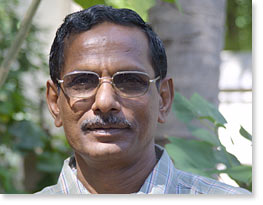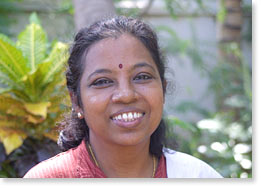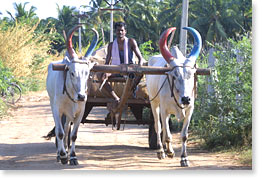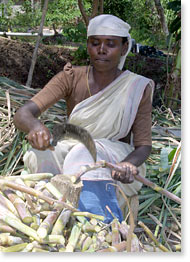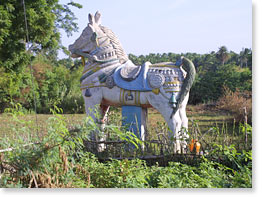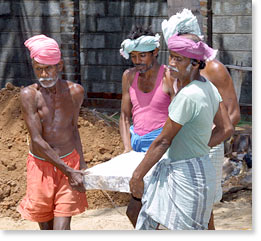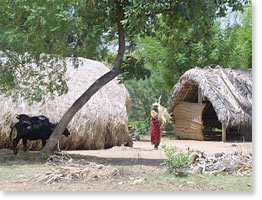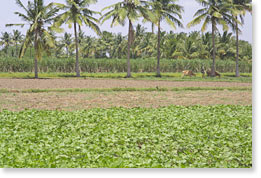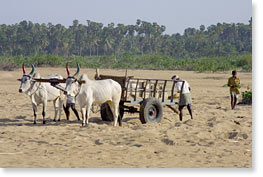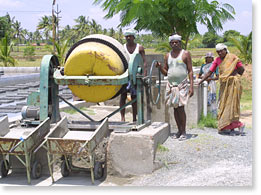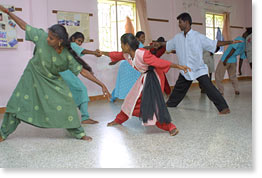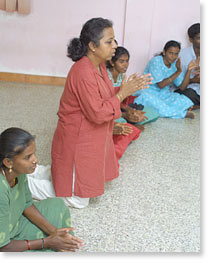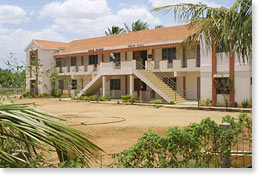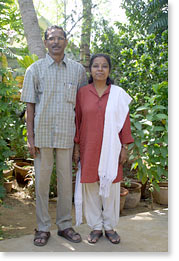|
Interview with L. A. Samy and Christina Samy of AREDS and SWATE (Association of Rural Education and Development Service) (Society of Women in Action for Total Empowerment) The poor have to be united / You create alternatives Renganathapuram, Tamil Nadu, India
L. A. Samy: I am L. A. Samy. I am the founder, director of an NGO named Association of Rural Education and Development Service, AREDS, which was founded in the year 1979 and formally registered in 1981. From the beginning to now it’s almost 24 years. The basic thrust, where we want to go, is to reach one humanity, free from oppression and poverty and injustice. The creation of one humanity where we are not divided by religion, language, race, caste, and the systems that keep humans apart. What are the things that we can create when humans come together? And the second thing is to help people to organize themselves to become aware of their reality, their socio-economic, political, cultural reality. To become aware and to collectively try to organize themselves to change their reality. It is not taking reality as a fate -- "Something I cannot change" -- but something I can change within myself. This change can happen only by making this consciousness spread among many people. Conscious and collective numbers can create a change for themselves. Development and education – Paolo Friere The programs of AREDS -- we have several programs, but all the programs are dealing with one concept -- development should not precede education. If you start development without education it will not sustain, it will not remain, it begins a program of service. That is, if the education is there, development will follow. Development will be sustained. So, you develop, you start opening up, you create changes, new ideas, and you perfect it -- it becomes a moment of change. Change itself is an end-point. This is the basic thrust of our work and to actualize that we have non-formal education based on the philosophy of, the strategy of Paolo Friere, “The Pedagogy of the Oppressed” and “Cultural Silence,” to help people to voice out, not bearing the things that we say: “You have to have perseverance,” “You should keep quiet,” “You should be silent,” “You should be patient.” But what is it to be patient? Patience is not simply adhering to somebody’s rules and regulations, rather adhering to your own rules and regulations so that you create a voice of the voiceless. To create the reality of, the experience of losers to winners. From docility to capacity. From silence to noise and voice. These are the basic end-points of a program that is based in non-formal education. Sangams -- discussing everything possible in life An organization of rural people. Here in rural areas you cannot, still, have men and women coming together and sitting together to discuss change in this country. So, you have to respect that culture until a time when it is possible to come together. We started with the organization of women in the villages and the organization of men in the villages -- two separate. We call these sangams. Sangam is a Tamil word and means -- it is not a club, it includes everything -- where there is a space of coming together and discussing everything possible in their life, which could be marriage, child-bearing, social concerns, or somebody is in difficulty and needs help. All that will be discussed in this kind of sangam. That is one major activity of coming together -- non-formal education leading to people coming together. You create alternatives. Alternative employment and agriculture Next, there is agriculture-dependent employment. You have to create a non-agricultural, independent world. That is, the majority of the people in this region were dependent on seasonal agriculture which had given them only about ninety days work in a year, which is a very, very minimum pace of work and you cannot take care of the families. So, in AREDS, first what we did was we created a lot of vocational trainings like tailoring, mat-weaving, wax-printing, textiles, hand looms, garment-making, shops for the women. A number of things which made them not depend fully on the seasonal agriculture; to have independent entrepreneurship which has opened avenues to nearby textile mills and textile garment making and export, which has enhanced their income. And this income has enhanced also the position of women in the family. These are alternative employments. And also an alternative agriculture: away from using lots of pesticides and hybrid varieties to what is locally available -- natural pesticides like neem leaves, neem oil. How to grow our own food without using any type of artificial means. People’s governance -- Panchayats And thirdly, we have started working in the local government, people’s governance, issues like the panchayats. What we can do in the name of rural development. How much we can use our powers to make our people get benefit from the government. To have a say in the happenings of the village. This is a major activity that we do, apart from the local grassroot level organizations. Focus on Dalits, women, children Our focus in the population is Dalits, women, and children for these happen to be the ones who are removed from the socio-economic political environment. They don’t have a great say in many of the happenings of their life. Historically, they are not people who own resources which can be used by themselves. To see some results, we started with the women savings and credit program. With the Dalits, also, we have the trainings and alternative employment and also a major program to create assets for the asset-less. These are the people who never had houses of their own, and even if they had them, they were only a kind of attached roof which can be destroyed any time. A fragile type of resource. Now we have a program of building houses for them. It’s called Dalits Social Housing Program which is a partnership -- it is not the AREDS who starts building. Our share is about one third. Two thirds of the money and material required for building houses is loaned by the Dalit themselves. The experience of constructing these houses has given them the experience that, “We have built ourselves.” In earlier times, it was somebody else. “This NGO built houses for us.” It was a recipe. But this way we consciously see that it should be, “We have done it together. We have responsibility together to create change in our livelihood.” This is how the housing is done. Apart from that, we have helped people to form themselves into groups where they can access local financial supports, like from the government or from the banks. This is a major thing where they are given the right perspective. That they are not begging but they are “demanding our right.” This is the basic thrust point of our work. Health is the responsibility of the people Health is another major thing. Health is the responsibility of the people and with locally available grains, grown in the region, we can prevent a major disease. Historically whatever we had, “Our health practices made it so that it is not good.” Now we say that whatever we had, though there are certain things superstitious, many things were good. Herbal medicine, anapestic, emetic, sidha. It has been time immemorial that they have been practiced. All that has been practiced: because it is not lab tested, doesn’t mean it is bad. Whatever has been the good things let us practice it so that way you don’t need to depend on injections, antibiotics which have so many side-effects. The local medical practice is the food itself. The leaves, the herbs that you take, it is changed into food. This is making them feel proud of whatever they are doing which has interesting, very good effects. Our program is basically health education and alternative health medical practices. We have our own nutritious food prepared, which is locally available grains, instead of buying tinned food and Nestle and things like that. We ourselves are making it -- with the local people. Also, our early education program uses cultural forms like theater, singing, dancing, and folk dances. All that has been used to impart health knowledge to the people. Three levels of growth As we grow, there are three levels. One is grassroots – directly involving the grassroots. Second is training and publications: a number of trainings, about 13, 14 trainings, have been given to NGOs, nationally as well as statewide, on rural development and various required subjects which are needed for the NGOs. And the third level is the lobby for policy change and networking. Christy Samy: My name is Christy. I am with AREDS from the beginning, I can say. From the time it got registered as an organization. As Samy said, it had its start from ’79, informally. I joined here as a person who is interested in involving myself for the rural population. I joined formally here in the year 1981 with our marriage. My main focus in the beginning was health programs. And simultaneously I started concentrating on women. Position-wise I am a program coordinator of AREDS. One of the outcomes of AREDS work is initiating people movements, people’s organizations. Among Dalits there was a movement initiated, and among women there was another movement -- called SWATE (Society of Women in Action for Total Empowerment). SWATE has been functioning since 1991, before which we had women organized in the village level as small units, as sangams. They were organized into small units of say 20 people, or in some villages 60 women, some 100 women. Their main focus was to address issues which they realized were the problems at that time. For example, they did not have a drinking water facility closeby. They had to walk maybe two kilometers or three kilometers. An electricity problem. There were no streetlights. No electricity for the village. Or road facilities to the nearby town. These were the main problems. And sometimes also issues like the agricultural work, they were demanded to work too long and paid very little. These were the kind of issues they started discussing among themselves in sangams. They started understanding through our intervention as AREDS that as a citizen of this country they are paying their taxes and the government is supposed to give them back all these facilities. A different language altogether Earlier, they thought that it was the fate of these women to walk a long distance for water and they have to be deprived of many facilities. That’s their fate, they thought. But, slowly, when this kind of education was going into all these different sangams, they started realizing it is their right to get these facilities in the villages. And slowly the kind of petitioning that they started doing had a different language altogether. Earlier, it was like begging and requesting and all that. And later, it’s like, “We would like that this is done for this village,” and “This is the demand from our organization and our sangam.” Slowly they started taking different strategies to address the issues. They went and gave the petition. They went in big numbers to make the issue understood and very close-by the officials would be the union office, which is there at their disposal, which they immediately would go and ask for. And slowly what they did, when things were not happening, they started giving ultimatums to the officials, bureaucrats, saying, “By this time, this should happen. If not, all of us will come and sit in your office with all our children and families.” So there were pressure tactics that they started using. For the first ten years, from 1981 to 1990, this had been the experience in the villages, which slowly in this area became an experience for all the villagers -- apart from the women groups who were taking up these kinds of issues to the government. Even for the public, for the other people, their own husbands, it was a revelation to understand that women started bringing a lot of things back to the villages, which, earlier, men were trying to get but nothing was happening. One man, who was understood as a leader, taken for a leader, would just go walk up and down to the office and come back and say, “They are coming. They will be doing (what we want).” And, “It is happening.” But nothing was happening. Yet when these women started moving out things started really coming back, to the extent they started having house patas, house deeds, land deeds for the housing. And free housing schemes. And wells dug right in the middle of the villages. They need not walk a long distance. And things like that. In some places they even put demands for proper functioning of the local schools where it was not properly functioning -- the teachers were not coming. So, a number of issues they started addressing and giving an experience to the villagers that they could do things. At the end of the tenth year, the women started realizing that they were not the so-called women that society was teaching or making the women to understand. That is women are supposed to be people who are just looking after the families, inside the kitchen, to care for the children and the husband. That’s all they were expected to do. But this experience, it was an experiential conscientization that was happening for the women. It helped them to understand that they are women with power. They are women who can make decisions and solve problems, the common needs of the villages. Slowly they started realizing their self-esteem. By the year 1990, they started addressing issues that were related to gender and women. Until then, they did not realize that the husband beating them is something that is taken for granted. “Yes, when I am married to a man, if a man is angry or upset with anything he can beat. Is something wrong about it?” That was the kind of perception they had. But, slowly, due to the self respect that was growing within themselves during the first ten years, they could no more tolerate this kind of ill treatment in the families. When they came to the sangam meetings they started talking about these kinds of issues, that “My husband is beating me every night.” “(He comes home) drunk” and things like that. Or when a girl is raped in the village, it used to be just a secret and it would be covered up. It would not be brought out that easily. Walking from one village to the other They started issues that are related just because they were women. And from 1991, these women, when they came together for a particular event of padiatra, padiatra is a rally, they walked from one village to the other highlighting the rights of girl-children. They decided to do that because 1990 was declared a year of girl-children. They came together and did that and from then they decided that, “We had been functioning in small units within our villages. From 1991 we better come together as one federation and form a movement.” And it is from 1991 that SWATE, the movement, was initiated. From then, they started becoming a very powerful movement in this district. In Karur district. So, with all the women sangams, with their representatives coming together as executive members, they formed this movement. From then, the issues they started addressing were much higher. Particularly that of the violations of the rights of women, of various kinds of violence that women face: starting from the domestic violence; to even becoming conscious of some of the legislations which are not in favor of them; to coming to actions at the district level; of being in solidarity with state-level actions. The government’s policy on alcoholism One of the major issues that they realized as women, as SWATE, as a movement, was that men drinking is something that is very common. It was always leaving the family with more poverty because in most of the families who are poor the men were drinking. When they drink, they drink really, really too much. Every day they drink, they are not really sure that they will have money the next day to drink. So they drink to the maximum and they become drunk and come back home and make a lot of problems for the women, beating and demanding things which he doesn’t realize cannot be provided in the house. Like very rich food and things like that. This habit was really becoming a kind of addiction. The whole income of this one person would be stopped for the family and the woman had to go work, and bring home, and manage within the small income. Even, at one stage, the men would start taking things, valuables, from the family and selling them off and drinking. The education of the children would be effected. The whole unity (of the family was) destroyed. This had been the experience of a number of women in the movement and they started bringing up this issue. At one point, what they realized was that it is not a problem that is related just to a family, they started understanding that the government’s policy on liquor, on alcoholism, has to be addressed. This movement of women realized that from 1972 the policies started changing in the state of Tamil Nadu, with regard to liquor, when the prohibition was lifted. The whole problem started then, in the sense of many men started drinking. Before, if any one man drank then everybody will be raising their eyebrows. It would be news in the village if he behaves very bad. But it has become such a common thing just because the policy changed. They started understanding that this has to be addressed with the government. Not only trying to change the husbands, which has to happen, but at the same time demanding that the government change the policy itself. They realized that their strength as SWATE within the district is not enough and realized that it should be a state-level movement. So, that is how they started inviting many federations from other districts of the state and had a conference, discussed the issue, and initiated a state-level movement called Tamil Nadu Anti-Liquor Movement. The environment, particularly the sand
So, the protection of the river, the water, and the sand was one of the major concerns of this movement. Women’s Movement Against Poverty and Violence Another initiative of this movement is a state-level one called Women’s Movement Against Poverty and Violence. In the year 2000, there was a global march that was happening against poverty and violence on women which was called World March of Women 2000. It got launched March 8, on International Women’s Day, in most countries, starting in Quebec, Canada, and finished in New York, giving a petition to the United Nations organization and also with demonstrations in front of the World Bank and IMF (International Monetary Fund). It was a representation of all women’s movements from a number of countries. It was an interesting process that took place and it was directly addressing this whole issue of increasing poverty and violence on women because of the globalization, privatization, and liberalization policies. SWATE participated in this campaign in a very active manner. It initiated a state-level rally in Chennai, in the year 2000. We mobilized nearly 50,000-odd signatures on white cloth, it’s like doti -- a long piece of white cloth -- all over the state in solidarity and collaboration with a number of NGOs and women’s organization. It was all sent to Delhi to the national coordinators of this rally, for this march, and it was taken to the international event in New York and Washington. Then, what happened was SWATE realized that it should be not be finished, like a celebration. The many women who came and participated in this march, marching in Chennai, (they) should be continuing action against poverty and violence. So, in the year 2001, a number of consultations took place among the NGOs and the women’s organizations at the end of which we initiated this movement -- Women MAPOVI, that is Women Movement Against Poverty and Violence, and today we have one lakh twenty, 120,000 members, in this movement, all over the state. This is another initiative of SWATE. In Motion Magazine: How many people are involved in the direct organizing that you do? You’ve mentioned these large movements, how many are you directly working with?L. A. Samy: We work in 90 percent of the district, which is about 500,000 population. In various ways we are involved with them. Christy Samy: Today, we have nearly 530 villages where we have the SWATE members. Two representatives from all these villages form the general body of SWATE. In Motion Magazine: And you started working in this one little village, Renganathapuram, and grew out from there? L. A. Samy: Yes, just one village. Christy Samy: It started here in this village. The same village, from the beginning. In Motion Magazine: How many people live in this village? L. A. Samy: Six thousand. It’s one of the biggest villages in this panchayat. Alive and awake to the needs of the villagers In Motion Magazine: How do people become involved? L. A. Samy: People start seeing AREDS as part of themselves because of the way we started building a rapport. When we came to this village, we started to live and work and earn like them. That was something which was very new for them. An educated person coming to their farm, coming to work with them in agriculture and sitting with them and eating what they were eating. This is the informal, as I said at the beginning, the non-formal education methodology of Paolo Friere and Saul Alinksy’s strategy of pressurizing the rulers or the owners to bend their laws in favor of the workers. This has been the thrust point where we did not separate ourselves from the lives of the people with whom we were going to work with, with whom we are going to change. I think that is what made a big difference. From the very start of the work, when I came here as a research student, until today, we are living in the village. And the changes that have taken place in this office and in this organization -- every brick they know who laid it and why. It is not like we suddenly came and started an organization, and built a building, and an office was set up. It has evolved based on the needs of their own selves. It may not be an exaggeration but it is one of the (only) organizations which started in the rural areas and is still surviving. As my experience goes, many of the NGOs were started in the villages in the beginning, and for one reason or another the organization gets based in nearby cities and towns. You are freeing this village but your office is in the city. Maybe it’s good for them, but at the same time we found it has a lot of difficulties. Because you are banged every minute here. You should be alive and awake to the needs of the villagers here. The second thing is that they have to own it. It is not just the office and administration it is ultimately for whom it has been created and by whom it has been created. It should be owned and controlled by themselves. Ninety-nine percent of the staff who are working at AREDS are people from the villages, from this area. That is a major advantage that we have even if AREDS gets closed for various reasons -- no finance. The work of AREDS will never stop because all the staff has 13 years experience, ten years experience. They have been dealing in the issues of the people. Even if there is no finance they are housed in the village and the people will always take the help of these people -- persons who have been involved as a culture. It has become a culture of involvement. They cannot stop answering and being a part of the people’s issues. We believe that the people’s power is the most important thing. Ultimately, the whole philosophy is that small people with conscious and collective numbers can create another world. By small people, we mean people who are socially, economically, politically, culturally alienated. If they know why they are alienated, the reasons for their alienation, they can come together, not only as people of this village, of course it has to start somewhere, but people of the world. We have to transcend our imaginary boundaries. The change cannot happen in isolation of the other parts of the world. So for us humans we should be able to see that we have a power together and we have the ownership together, not as an individual who can grab a major part of the thing. It is actually questioning the very structure and system of the so-called Western rules. It is where you see all these movements going, all these initiatives. Today, right from 1995, you see a very strong global attack, in the sense of a global system attack of globalization, liberalization, and privatization where a faceless colonialization is taking place. It is a new colonialization where you are even losing the little things that we are gaining. Before that we were able to struggle and get things like drinking water, something we could achieve. Today there is water but you have to pay for it. It is a drastic change within a decade that whatever we were getting which was available naturally, like water, grazing land, fuel wood, fodder -- now we have to pay for it. Already we are victimized because of the social system, the economic system -- the poor are further marginalized. And survival becomes very, very difficult. Therefore we need to create, make small people to become conscious of their power to get united so that they can create alternatives and become owners of the world. Not individually but collectively. This is the main thrust that underlies it. A right over my body and also over my ideas There is a culture of, “If I have a difficulty in my family, it’s not good that I tell about my difficulties with my neighbor.” The same thing persists when a husband beats the wife -- the wife may not tell to the neighbor that she is getting beaten up. It is taken as a culture. So the woman has to bear it and her husband has a right to beat. That means you start accepting yourself that your body is not your property, but your body is somebody’s property. So how do you change that? It is education and organization that helps one to understand that I have a right over my body and also over my ideas. How do you it? You have to break the entire system that makes this the best thing. It is the same with the neighbors And secondly, like the question of water which has been the responsibility of women to bring it, men will not know where she brings it out of, how far she has to go and bring the water. That’s not his problem. But it is the women’s problem. Taking care of the children is women’s problem. She is made to think and grope with the problem of water only within the four walls of her house. This is a very, very big problem for her -- to dig a well and have her own well, which is impossible. What the organization, AREDS has helped them to see is it is the same with the neighbors. It is the same with the whole street. And it is the same problem with the entire village so that the one person’s problem becomes a problem of the village where it can be solved. The number of people who become conscious of the issue is bigger, so the share of the solving also becomes easier. This is the typical ongoing experience of making the losers to become winners in life. The poor are the majority. The majority number is divided. So how do we make the number as itself a power. The power of the poor is in their collective unconscious numbers. The only thing is that here the poor is not united. The strategy in the program should be that we poor have to be united. This is the entire education and organization program of AREDS. Issues which are also affecting them Christy Samy: Most of the members have become members of AREDS’s initiative movements just because they started understanding that this movement’s members are involved in issues which are also affecting them. And they started benefiting out of their involvement and struggling for, not just taking something to my house, to my family, but being involved in issues that are common for the village, are common for a much larger population. Slowly, many, many people started understanding that these women, or these Dalit groups, are much beyond just this small petty satisfying of their needs. It is much greater and “Why not I become (involved)?” Particularly in the last three to four years, the impact of privatization has been very strongly realized by the people. In the last three years, the poverty is becoming much higher because of the losing of employment. For example, basically, this area’s main occupation is agriculture. And the second main occupation is textile works. But today the agriculture activities are literally coming to an end because the whole pattern is changing due to mechanization. Even for harvesting you have big machines coming. Eighty percent of agriculture work in India was carried out by women and now only planting is done physically, whereas with all other things you do have machines. Of course, because of a lot of our involvement in a number of villages there is a resistance for allowing machines to come in for harvesting. Even in a place where a hundred women would be working, just ten will be enough to go along with the machine and do some work. And secondly, the subsidies, the facilities that were paraded by the government, or by the banks, for the agricultural investments and activities are completely cut. The investment cut is becoming much higher because now the farmers are losing their say in fixing the cost of their product. Encouraging export-oriented products In Motion Magazine: In what way are they losing control? Christy Samy: There is an import of rice from China and sugar from Pakistan. This is because of the GATT agreement. You have a contract where a number of things should be imported -- that is one of the conditions. But we have enough rice in the country. We have enough sugar cane in the country for making sugar, according to one of the statistics which is now everywhere spoken about. Six crore (60 million) tons of grains are stored in the granaries, whereas you have 30 crores of people, population, who are having starvation problems – who are under starvation. This is a big contradiction. There is even a case that was filed in the Supreme Court by one of the human rights organizations against this issue of storing grains while you have so many people under starvation. And now, there is this wasteland development that was brought in by the Tamil Nadu government. Under this scheme of wasteland development, they are planning to give away a thousand acres to one particular business house, to develop this so-called wasteland. Wastelands are mostly the grassy, grazing lands for the cattle, which is owned by the government, which is not private land. But by giving away all these government lands to private houses, companies, and business houses, they are only encouraging export-oriented products. This is the trend that the whole interest of the government is going into. For the small farmers it is becoming very difficult because the investment cost is very high. Most of the small farmers are now selling away their land to other people, big landowners. They say, “Because I am not finding any profit out of it.” What I am trying to say is, people start realizing the poverty straight in their day-to-day experience. They start understanding that they can’t go on like this. You will have heard about this government employees' strike that took place recently. A big number of government employees, all over the state, were under an indefinite strike because of the cutting down of the usual benefits they had. Some of their bonuses and the pension. There was a small cut in the pension. The Supreme Court has passed a condition saying that no more the government employees have the right to strike. And so there is also again protest. This is the kind of change in the law because of this whole policy of globalization. These are the conditions from GATT and SAP (Structural Adjustment Program). The common people, the middle class, and the lower middle class and the people below the poverty line they are straight experiencing these changes in the last two years very, very severely. And now people start looking out for “How to sustain myself?” How to survive. Things are so uncertain and insecure. This is another situation in which we see that people really look for a movement which has got its own political stand -- and particularly for the grassroots people. You do have the conventional way. We have the trade unions and the organized sector which is always having this kind of possibility. NGO-initiative women federations go to one level and stop. They are not really politically going very strong because a number of NGOs still have their strings with their initiated federations, people’s organizations. They won’t let it go on their own. Whereas SWATE has its own political stand and AREDS, though it has initiated this movement, it has nothing, no decision making, no string attached to this movement. SWATE has an explicit self, a very strong political movement, a number of people: grassroots women, particularly; and the farmers who find a lot of inspiration and would like to be in collaboration. L. A. Samy: We have the cultural forms which have been existing for time memorial, which is the art of the people, like singing, dancing with the sticks. In Motion Magazine: Specifically the Tamil people? L. A. Samy: Yes, the Tamil people. But it is everywhere. In their own regions, people have their cultural forms. And basically the cultural forms of the local area are participatory. It is not somebody performing and the majority watching. The role is very much changing. It is part of their self. (It is in) a space, an open space for the entire community where such forms are conducted, where at one point of time the artist becomes the observer and the observer takes the place of the artist. You can always learn and do things. Some mobility. It is a physical mobility as well as the emotional mobility that is there. There is a kind of sharing. In the other arts, like the theater, the cinema, you don’t even see the persons, you only see the images. The rest of the audience is a silent spectator. The dialog is between you and the image. But here the entire self is a collective self. Immediate criticism also takes place. It is part of life. It becomes a life art. This is something which has been missed due to high tech and the media -- one-way communication. This is multiple ways of communication. Creating awareness. The AREDS Children Theater School When we speak about gender justice, gender consciousness, and also the Dalit consciousness, where the caste system is dividing it, we are addressing the others in a scientific and analytical way but there is no living experience for them. It takes time, in their own way. That is why we wanted to start the AREDS Children Theater School. Basically, right from the very start, at a small age, they get a living experience of this art, coming together as girls and boys. Staying together for about two days or three days. Allowing them to express themselves in whatever capacity they have. These are the people who have never been appreciated. Dalits performing an art is not appreciated by the majority. The high caste will never appreciate it. They will always look down. Whereas every human person has the innate tendencies to bring out some capacity, her own capacity, to create a self-confidence, a self image that this person of this community and another person has an equal sometimes higher potentiality to exhibit and to bring into the world. Their aim in their thinking becomes much wider than the small space they are operating in. In Motion Magazine: What specific forms of art? L. A. Samy: Dance, music, drawing, speech, traditional drums. The approach is to accept In Motion Magazine: Organizing isn’t easy. People don’t always just sign up for committees. Yet you have achieved huge organizations playing great roles. How do you do that? L. A. Samy: It is not easy. I think the approach is to accept. When I started the work, the approach earlier by anybody who goes to the village, you had the so-called educated person who knows everything and the non-educated knows nothing. This is the attitude of the relationship. When I came here, I said, “I don’t know anything about agriculture and you know many things about agriculture because you have been working.” So, at first, you are making somebody as your teacher who had never been accepted. (Letting them know) that they know something better than the other person. This approach, only, has made them to accept me as a student. You make somebody who had always been taught they are lower as somebody higher than you. They cannot even talk to them. We listen to them. So that myth is de-mythalized. Similarly, if we take the medicines, “You know much better than anybody else in this world,” because we have survived so many thousands of years without allopathic medicines and allopathic medicines are only a recent happening, a recent push into our life. If you have survived with so many medical practices why not accept it as ours. You make the local initiatives, local practices, local customs as something in itself as value. Similarly, like you say, the art. The drumbeats which are supposed to be low caste, as if this isn’t art. Nobody else can do it. Personally, I believe that is true. It is not by artificially saying that something is so to make people come together. Rather to really feel it. This is something unique and this is ours. That kind of acceptance and feeling proud about whatever they are doing. This is the approach that made them to come together. And extensively use it. The meaning of art is something that makes a collective. A movement that makes people grow together. Not a one-way communication but a multiple way of communication and it is a direct communication. Using street theater In Motion Magazine: Can you (Christy Samy) say how art is a part of your organizing? Christy Samy: Art has been in AREDS since day one. We have been using it because I think of us as quite convinced about what it has done in our lives personally. As he said, this is something that when we started we had not a real procedural workshop, but personally, individually, very much relished art in very many ways. So, when I said from day one, we have been really taking art into the villages. In a festival, we had a group of women, a group of young people. We called them together, started creating songs, and a folk dance and performing in the village. It started like that. Slowly helping in the creativity and expression of the people. And later I had the chance of undergoing a workshop with one person called Madut Sekhar who is from West Bengal, Kolkata. And then I had another opportunity, of putting myself a lot into the theater to use street theater in education, in conscientization. Next, I happened to go to the Beijing Women’s Conference as a theater person from India. We were twenty from all over India, and we did a big stage performance at the Beijing conference in one of the workshops. And I happened to come across the Playback Theater. Playback Theater is theater that was initiated in New York in the United States. It is to build a community spirit and for people to come up and share their real-life stories with others. It is an improvisation theater. You don’t have a play that is ready to perform. But the actors are there and there is a conductor who coordinates the whole thing. It is a play from the story that is told at that moment. This is the Playback Theater which we have been using very, very much in our work from 1994. And I keep going to the international Playback Theater conferences. So, we had a group of women first, a purely-women group from SWATE, who did a number of performances in the villages -- street theater with various themes. A very big reality could be very simply communicated to the population like ours who are not literate. You can’t keep on going and giving lectures. You can’t give out print materials to make them understand. But with theatre it was very easy and quite quickly reaching them. A major contribution for the building of the movement is theater. Performance and audience We see theater in two levels. One, it is a process by itself. This is an alternate theater. There are people who do performance and people who are audience. It is not a usual stage performance. It is a theater that has a constant communication: to be in touch -- and there is a response from the audience too. It is a two-way thing. This is a process by itself. It takes the audience from one level to another level. It leads up to reflection and the reflection leads them to action. Either to become part of the movement or to search for, “How I can change my situation where I am deprived of so many rights.” To defend themselves or to protect And the second level. (It is) a process as well as a sort of a tool or a weapon. It can create a very strong impact even on the other people who are on the other side of the court. At a number of demonstrations, when we have held actions that we have taken for various issues, particularly issues that are at the very macro level, and we demand the government to take action or change policies, we use theater, street theater. In the plays at the demonstrations we portray what really happens. Who is the oppressive element? Who are oppressed? And how people are wanting to attack this. People, once they become conscious … it can become a weapon to defend themselves or to protect. For us theater and art is something very, very close to our work and we use it a lot in our work with regard to Dalit people, and women, and for children. We also call for children every year during the summer children theater workshop. We see that children should be helped in this, continuing their values and understanding in spite of the many forces that are oppressive and discriminative. We look forward to breaking away a lot of barriers that are there in the society to start experiencing this closeness of children when they are together, and to bring out all their potential. Published in In Motion Magazine November 6, 2004 Also see:
|
||||||||||||||||||||||||||||||||||||||||||||||||||||
If you have any thoughts on this or would like to contribute to an ongoing discussion in the  What is New? || Affirmative Action || Art Changes || Autonomy: Chiapas - California || Community Images || Education Rights || E-mail, Opinions and Discussion || En español || Essays from Ireland || Global Eyes || Healthcare || Human Rights/Civil Rights || Piri Thomas || Photo of the Week || QA: Interviews || Region || Rural America || Search || Donate || To be notified of new articles || Survey || In Motion Magazine's Store || In Motion Magazine Staff || In Unity Book of Photos || Links Around The World NPC Productions Copyright © 1995-2018 NPC Productions as a compilation. All Rights Reserved. |


